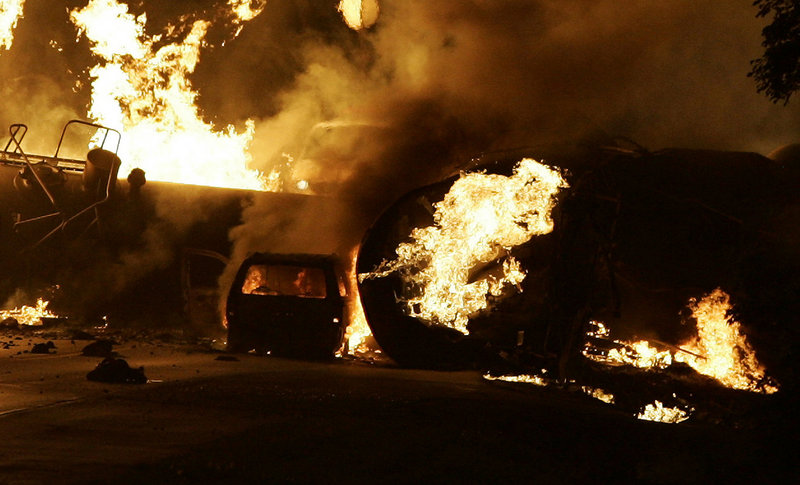CHICAGO – For two decades, one of the most commonly used types of rail tanker has been allowed to haul hazardous liquids from coast to coast even though transportation officials were aware of a dangerous design flaw that almost guarantees the car will tear open in an accident, potentially spilling cargo that could catch fire, explode or contaminate the environment.
The rail and chemical industries have committed to a safer design for new tankers, but are pressing regulators not to require modifications to tens of thousands of existing cars, despite a spike in the number of accidents as more tankers are put into service to accommodate soaring demand for ethanol, the highly flammable corn-based fuel usually transported by rail.
Derailments have triggered chemical spills and massive blasts, like one in July in Columbus, Ohio, that blew up with such intensity that one witness said it “looked like the sun exploded.” Some communities with busy railways are beginning to regard the tankers as a serious threat to public safety.
“There’s a law of averages that gives me great concern,” said Jim Arie, fire chief in Barrington, a wealthy Chicago suburb where ethanol tankers snake through a bustling downtown. “Sometimes I don’t sleep well at night.”
He’s not the only one. The town’s mayor is trying to build a national coalition to push for safety reforms.
The tanker, known as the DOT-111, is a workhorse of the American rail fleet, with a soda-can shape that makes it one of the most easily recognizable cars on freight routes.
The tanker itself is not suspected of causing derailments, but the National Transportation Safety Board has noted several worrisome problems: Its steel shell is too thin to resist puncture in accidents. The ends are especially vulnerable to tears from couplers that can fly up after ripping off between cars. And unloading valves and other exposed fittings on the tops of tankers can also break during rollovers.
The flaws were noted as far back as a 1991 safety study.
An Associated Press analysis of 20 years’ worth of federal rail accident data found that ethanol tankers have been breached in at least 40 serious accidents since 2000. In the previous decade, there were just two breaches.
The number of severe crashes is small considering the total mileage covered by the many tankers in service, and the rail industry’s safety record on hazmat shipments is strong. More than 99 percent of hazmat rail shipments arrive safely at their destinations.
“Safety is the freight railroad industry’s No. 1 priority,” said Patricia Reilly, senior vice president of communications at the Association of American Railroads. She said freight railroads work with experts and federal regulators to develop “rigorous standards for hazmat tank cars.”
“Rail continues to be the safest way to transport chemicals,” Reilly said.
But the accident reports show that since 1996, at least two people have been killed by balls of flame, with dozens more hurt. And the risk of greater losses looms.
Send questions/comments to the editors.



Success. Please wait for the page to reload. If the page does not reload within 5 seconds, please refresh the page.
Enter your email and password to access comments.
Hi, to comment on stories you must . This profile is in addition to your subscription and website login.
Already have a commenting profile? .
Invalid username/password.
Please check your email to confirm and complete your registration.
Only subscribers are eligible to post comments. Please subscribe or login first for digital access. Here’s why.
Use the form below to reset your password. When you've submitted your account email, we will send an email with a reset code.